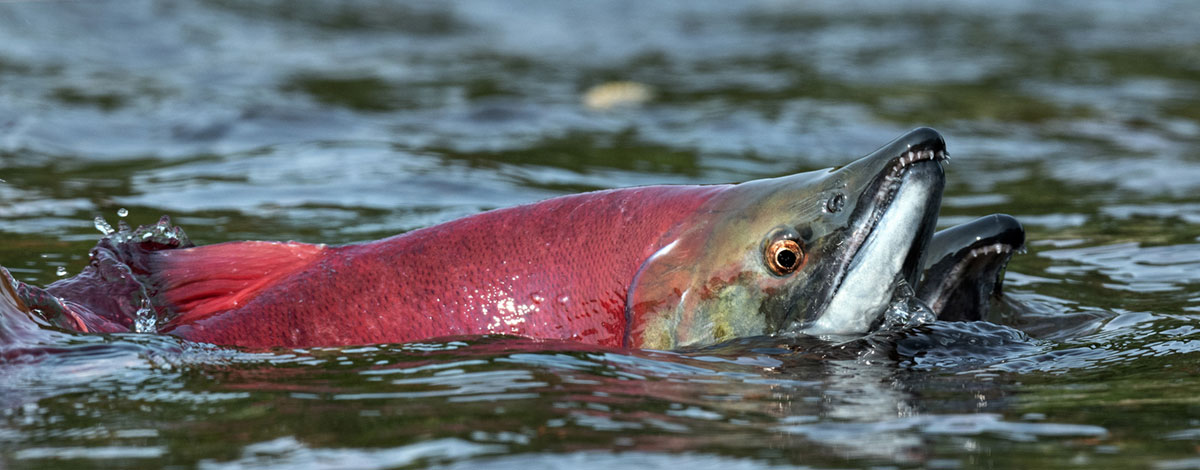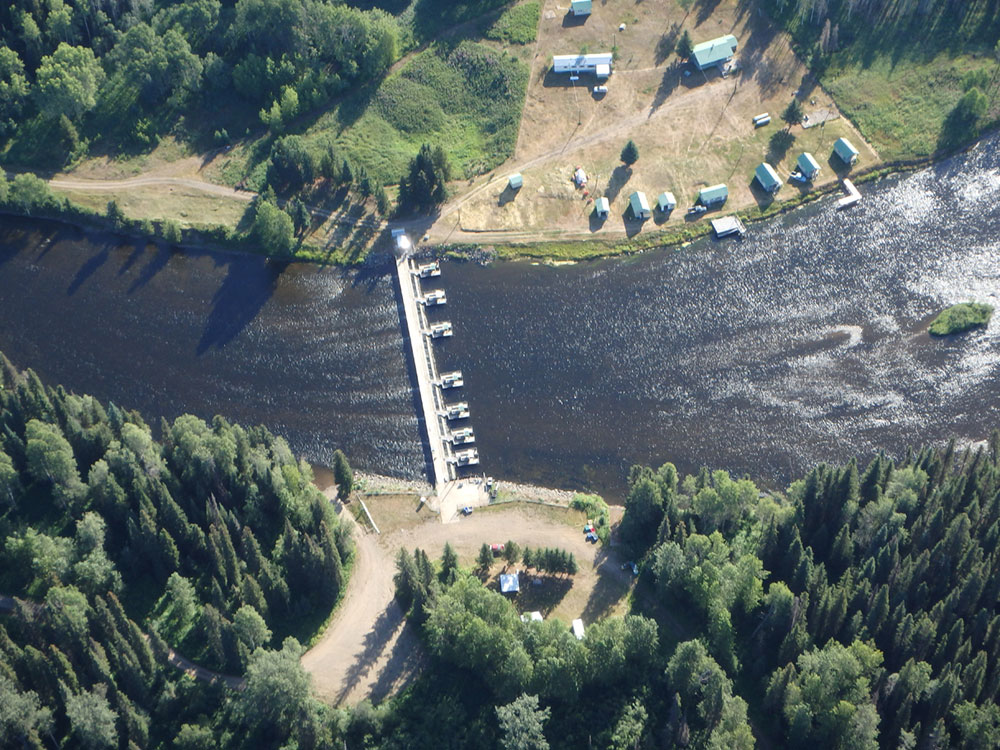Fisheries and Oceans Canada says it has no plans to close a popular sockeye fly-fishing area on the Babine River despite concerns from the local First Nation that high water temperatures are negatively impacting salmon — and despite that First Nation’s announcement that it would take matters into its own hands by closing the fishery itself.
In an email, the federal fisheries regulator, which is commonly known as DFO, said it is monitoring salmon returns and doesn’t believe this summer’s high water temperatures and low flows present a threat to the recreational, commercial or First Nation’s food fishery at the Babine River fish-counting fence.
“Although temperatures above 21 C are known to be harmful to sockeye, observations of fish passage to date have not reported any delays in movement past the fence related to high water temperature,” DFO strategic communications manager Dan Bate said in an email.
While the federal fisheries regulator described 21 C as a threshold “established in the scientific literature for degradation in the performance of sockeye salmon,” it confirmed it has no specific temperature trigger in place for closing fisheries in the Babine watershed, which produces roughly 90 per cent of all sockeye salmon that come out of the Skeena River.
Donna MacIntyre, fisheries director for Lake Babine Nation, accused DFO of pulling numbers “out of a hat” and said the nation is stepping in to protect salmon where the federal government has failed to act.
“LBN has been stewards of this fish since time immemorial and if nobody’s going to do it, we have to do it,” she told The Tyee. “The safest thing is a precautionary measure. In order to make management decisions, you need some policy in place.”
Lake Babine’s fishery management plan puts the threshold where salmon are negatively impacted much lower, at about 18 C.
The nation says it will close recreational fishing to preserve future stocks, asserting that water temperatures at the fish-counting fence have consistently hit 18 C and sometimes higher this summer.
The fence, which is owned by DFO but managed by Lake Babine Nation, is where researchers record the exact number of salmon that return to the nation’s territory. It also presents a physical barrier to migrating salmon.

As salmon back up downstream, they are immersed in warm water that skims off the surface of Nilkitkwa and Babine lakes above, as the channel narrows into the Babine River. Migrating salmon are left holding in the warmer water, expending energy as they wait their turn to find refuge in the deeper, coolers pools of the lakes.
That leaves them vulnerable to disease, parasites and exhaustion, research indicates. For unknown reasons, female salmon are more likely to succumb to high temperatures, further putting future stocks at risk.
“They’re dying before they’re able to lay their eggs and have them fertilized,” Adam Wrench said.
Wrench is an environmental consultant who worked with the nation to create its fishery management plan two years ago. In the absence of research specific to Skeena salmon, he used data from the Fraser River watershed — in addition to local Indigenous knowledge — to set temperature thresholds for closing the recreational fishery.
He said the nation opted for a precautionary approach. While DFO was asked to review the plan, the department never responded, he said.
Lake Babine’s plan sets out thresholds that Wrench said are at the high end of the fish’s optimum temperature range. It calls for a closure in the area immediately below the fish-counting fence if mean weekly water temperatures reach 15.5 C or if a maximum daily temperature reaches 17.5 C.
“We don’t actually know what the stress thresholds are for those given stocks, because it does vary widely, depending on where those stocks are located and how they evolved and what temperature they evolved in,” Wrench said.
“What the Lake Babine fisheries folks at the fence have noticed is that when the recreational fishing pressure is elevated, they’re actually just not moving at all through the fence. They’re just totally stalled out there.”
As a result, the nation would like to remove recreational fishers — which represent one final barrier on the several-hundred-kilometre journey the salmon take from the ocean to return to their natal spawning beds — from the area directly below the fence. They say recreational fishing is still welcome in other parts of the territory, such as the Fulton spawning channel off Babine Lake.
Eduardo Martins, who teaches ecosystem science and management at the University of Northern British Columbia, authored a report examining climate’s effect on salmon survival that informed Lake Babine’s fishery management plan.
He said an 18 C threshold makes sense.
“I think they’re taking a precautionary approach,” Martins said. “We know temperatures above 18 degrees reduce survival during the upstream migration.”
At 21 C, he added, “you can expect a lot of mortality, especially if there are interactions with other stressors.”
While salmon’s response to temperature varies by population, those that migrate mid-summer tend to be more tolerant to higher temperatures, he said. That’s good news for salmon currently in the Babine, but Skeena salmon are likely to have a lower thermal tolerance than those studied in the Fraser River, as a result of lower historical temperatures in the north, Martins said.
“Given that we don’t know anything about the relationship between temperature and survival for Babine Lake sockeye… I think that 17.5 C is a good starting point until we learn more about it,” he said.
DFO also acknowledges the impacts to salmon when water temperatures reach 18 C.
Its reporting on Fraser River salmon migration indicates salmon begin to feel the effects of warmer temperatures at 18 C, when the fish experience “decreased swimming performance,” with incrementally greater stressors up to 21 C, where “chronic exposure can lead to severe stress and early mortality.”
Some locations on the Fraser River have also consistently reached 18 C and higher, occasionally peaking at 20 C, over the past month, the reports show. On July 9, the Nechako River at Vanderhoof reached a daily mean temperature of 22 C, nearly five degrees warmer than the 20-year historic average.
DFO said that it has “no specific plan” for responding to temperature thresholds on the Babine River, but said the federal regulator is willing to work with the First Nation “to create a plan that encompasses all harvesting activities in the area and gathering information on temperature thresholds relevant to this area,” according to Bate.
He added that the regulator continues to monitor conditions and meet with Lake Babine to discuss measures that could “support fish passage past the fence.”
“DFO is the responsible authority for the proper management of the fishery,” he added. “Changes to opening and closing times are communicated to the public via fishery notices.”
In response, MacIntyre expressed frustration.
“If they’re the ones that are in charge of it, why don’t they care?” she said. “If they want to be responsible, then they should act responsibly.”
She said a crew representing the nation visited the Babine River as it opened on Tuesday, passing out educational material and explaining the closure. Only a few fishers showed up, she said, and they were receptive to the nation’s conservation message.
“This is going to benefit everybody, everybody, if we look after our wild stocks,” MacIntyre said.
BC Parks, which manages the Babine River Corridor Park, a narrow strip of protected area that extends downstream from the fish fence, said it’s aware of Lake Babine Nation’s concerns and closure.
A spokesperson said park rangers will support the nation in educational outreach but will not enforce the closure. ![]()
Read more: Indigenous, Rights + Justice, Environment

















Tyee Commenting Guidelines
Comments that violate guidelines risk being deleted, and violations may result in a temporary or permanent user ban. Maintain the spirit of good conversation to stay in the discussion and be patient with moderators. Comments are reviewed regularly but not in real time.
Do:
Do not: